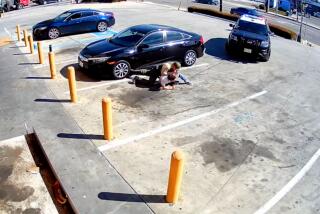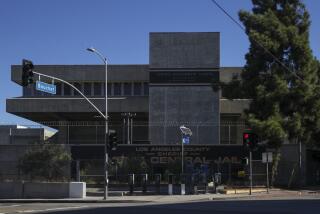U.S. Restructuring King Beating Case : Law: Grand jury transcripts suggest that prosecutors will call civilian eyewitnesses and will use a different LAPD use-of-force expert in the new trial of four officers.
- Share via
Federal prosecutors in the case of four Los Angeles police officers charged with violating Rodney G. King’s civil rights apparently have restructured key elements of the state case, substituting a new expert witness on Police Department use-of-force policy and laying the groundwork for civilian witnesses to testify in the upcoming trial.
According to grand jury transcripts obtained by The Times, several civilian witnesses testified before the federal grand jury during May and June. Those witnesses said King did not attack the police officers who beat him, as the officers have claimed.
The transcripts also show that Los Angeles Police Department Sgt. Mark John Conta appeared before the grand jurors the day before prosecutors released the indictments charging the officers with intentionally violating King’s civil rights.
Conta told the grand jury that many of the kicks and blows rained upon King that night were violations of the Police Department’s policy on the use of force. Cmdr. Michael Bostic testified as the government’s use-of-force expert during the state trial, but he acknowledged under cross-examination that his opinion of the beating had been formed after just five viewings of the videotape. Jurors later said they did not find him credible.
The grand jury testimony of the witnesses suggests that federal prosecutors are determined to bolster the videotape of the beating with eyewitness accounts and expert interpretation. Neither Conta nor any of the civilian witnesses testified in the state trial--which ended in not guilty verdicts on all but one count. Legal experts said that their appearances before the grand jury indicates they may be called this time.
“I think the prosecution is trying to present a fuller picture of this event than was presented in the state case,” said Laurie Levenson, a Loyola law school professor and former federal prosecutor. “The prosecutors realize that when they go to the jury they have to go with a variety of evidence.”
Erwin Chemerinsky, a law professor at USC, agreed.
“The prosecutors in this case have the benefit of getting to listen to all these experts who have analyzed the first trial,” he said. “If there’s something to be learned from the state trial, it’s that the videotape may not be enough to show that the force was excessive. They need to do much more to introduce testimony to that effect.”
There are risks in calling the civilian witnesses to the stand. Not all of them had ideal vantage points to view the beating and their statements are not always consistent. Some saw it from a distance, others from inside a bus with the windows rolled up.
Still, their testimony before the grand jury shows that they corroborate one another on some key details, including the question of whether King appeared to provoke the officers into beating him.
“What was Mr. King doing as he was being hit and kicked?” prosecutor Alan Tieger asked one witness during the grand jury hearings. “Did he hit the officers?”
“I did not see that he hit him,” the witness, Benjamin Becerra Avila, responded.
“Did he attack the officers?” Tieger asked.
“I did not see that at any moment,” Avila answered.
Nearly identical questions were asked of two other eyewitnesses, Dorothy Mae Gibson and Robert Hill. Both testified that they did not see King attack or threaten the officers.
In an interview with FBI agents, Gibson called the beating “sadistic.”
“I don’t care who he was, he didn’t deserve that,” Gibson said of King, according to the FBI report of that interview.
In his testimony before the grand jury, Hill said that King at one point raised his hands, but it appeared that he did so “to fend off the blows,” not to strike at the officers. Gibson gave a similar account during her testimony.
Many of the blows were administered as King lay on the ground, according to both witnesses.
That testimony, if repeated at trial, could be important because it backs up King’s account of the events that evening. By contrast, the defendants have said that King charged at Officer Laurence M. Powell and repeatedly resisted efforts to arrest him.
As long as King was resisting or attacking the officers, their blows would probably be justified in order to take him into custody--as long as the officers did not intentionally strike King in the head or otherwise use a level of force that would be considered potentially deadly. To find the defendants guilty of violating King’s rights, the government must show that the force used against him was intentionally unreasonable.
Conta, whose resume states that he is the officer in charge of the Police Department’s physical training and self-defense unit, could be a key witness in the prosecution’s case. He testified before the grand jury on Aug. 4, 1992, the day before indictments against the four defendants were unsealed.
In his testimony, Conta defends some of the blows that the officers used against King and says that others could have been justified depending on what the officers perceived at the scene. In addition, one blow that some authorities believe hit King in the head could have been justified if King were hit there by accident, Conta said.
But the bulk of Conta’s 88-minute appearance before the grand jury was devoted to his criticism of the officers’ conduct.
Describing one set of blows to King, for instance, Conta said that they were “out of policy” because King posed no apparent threat to the officers.
“You have to ask yourself, what kind of threat does Rodney King pose at that time?” Conta said as he viewed a videotape of the beating. “That’s an essential ingredient. And you look at a man in a prone position. He’s either on his side or his back. In this position, he appears to be on his stomach. . . . What kind of a threat, objective threat, does Rodney King pose?”
Under questioning from Assistant U.S. Atty. Steven D. Clymer, Conta also faulted Sgt. Stacey C. Koon, who did not strike King but is charged with violating his civil rights by allowing officers under his supervision to carry out the beating.
“Does the sergeant on the scene have any obligation with respect to stopping those blows?” Clymer asked.
“Absolutely,” Conta responded. “A sergeant at the scene has the responsibility to control that scene. He is there to take charge. He is the highest ranking individual at that scene. It is his responsibility, and he is held accountable for the actions of everybody there.”
More to Read
Sign up for Essential California
The most important California stories and recommendations in your inbox every morning.
You may occasionally receive promotional content from the Los Angeles Times.














